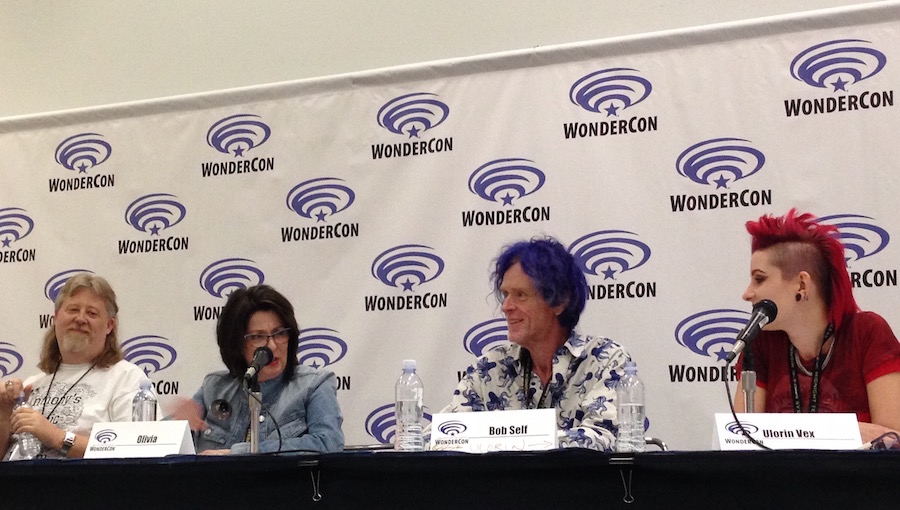In the realm of pinup and cheesecake artwork, there are several important artists who have had a profound impact on the genre. These include luminaries such as Jim Silke, Dave Stevens, Alberto Vargas, and Gil Elvgren. Olivia De Berardinis is another influential pinup and erotic artist, known for her depictions of powerful women and iconic ladies such as Bettie Page and Julie Strain. De Berardinis has been prolific in her craft for nearly four decades, and a Saturday, April 1, 2017, panel at WonderCon provided an opportunity to not only honor her and her work, but provide an interview and Q&A session with her fans, as well. The panel was moderated by Bob Self of Baby Tattoo publishing, with model Ulorin Vex and De Berardinis’ husband Joel Beren chiming in, as well. A wall screen complemented the dialogue by showing many different pieces De Berardinis had realized over the years.
De Berardinis’ career began when she was twenty-five in the 1970s. Prior to her shift to creating erotic art, she was enrolled in art school which she rarely attended, and she had pieces exhibited in galleries in Soho, but was not having much success. She described it as “spending six months a year creating art and the other six drinking and admiring it.” She had a series of boyfriends but found that none of them were giving her the encouragement and support she needed. Eager and ambitious to turn this scenario around, she created a small portfolio, and since she could draw women quite well, she engaged with the various sex magazines. She wound up being embraced with open arms by the different men’s magazines – Swank, Club, Hustler, Penthouse, Playboy, etc. – and treated quite fairly despite her gender. She even said that Harvey Kurtzman from Playboy had jumped on his desk in joy at the prospect of having her on board.
Only a few of the publishers dictated what she could draw, thus De Berardinis enjoyed a tremendous amount of artistic freedom in her art. Oftentimes, the magazine’s writers would pen erotic and fetish narratives to complement her pieces. Sadly, though, De Berardinis lamented that most of her work during this period has not been seen by modern fans and admirers and uses her con appearances to gauge interest if these early years should be republished.
De Berardinis elaborated on the era that this artwork was a product of, being during a sexual revolution, where “maturity was being pushed back then. It was a time and place that doesn’t exist anymore.” Though the magazines were treating her well, in general women during this time where thought “not to enjoy sex and not supposed to be forward thinking.” She made many allusions of these years to being like that of the show, Mad Men, and talked of her art being considered “erotic” and her desire to transition the labeling to “pinup” as it is a softer word.
While the word “pinup” certainly has less aggressive connotations, De Berardinis confessed that the women she draws are aggressive and “in charge of their own sexuality.” In her early years, before she could afford models, she would use a “cut up method” of takings arms, legs, faces, and other body parts from magazines and assemble them into a new woman for her to work from. Now, she works with models and combines them with mythological attributes, creating pieces she believes are imbued with “fantasy realism.” Ulorin chimed in to talk about her modeling work with De Berardinis, saying she was nervous at first and worried to make a bad impression, but that De Berardinis makes her models feels safe. De Berardinis agreed and added that, “If you photograph someone long enough, they melt down.”
When asked about the different magazines she worked for, De Berardinis quipped that “Playboy was like Disneyland, but Hustler paid the most money to try and attract the talent.” She described Hugh Hefner as wanting “sweet, compliant women” which contrasted with De Berardinis’ more aggressive style. She mused about the “cheesecake” style of art, saying it is a rare talent to have to pull it off, and she herself has been at it for decades but confessed it to be difficult.
When asked what other projects she would like to work on, De Berardinis replied that no one ever asks her to do comic book covers, but it was something that she really wants to do. She joked and said that since she had worked in the sex world for so long, folks simply assume she can’t draw clothes. She said that she took all her jobs as a learning experience. For example, with her working at the sex magazines she was able to learn much about anatomy. She also discovered her fondness of watercolor, and that doing it everyday she got exceptionally proficient with the medium.
The panel concluded with everyone being invited to De Berardinis’ booth to see her artwork and her many pieces collected in book form.
Panel photo provided by Nicholas Diak.
Nicholas Diak is a pop culture scholar of industrial and synthwave music, Italian genre films, and Lovecraft studies. He contributes essays to various anthologies, journals, and pop culture websites. He is the editor of the forthcoming anthology, Ad Victoriam! Essays on Neo-Peplum Cinema and Television. He can be found at nickdiak.com.

